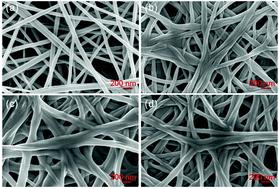Our official English website, www.x-mol.net, welcomes your
feedback! (Note: you will need to create a separate account there.)
A potentiometric sensor based on modified electrospun PVDF nanofibers - towards 2D ion-selective membranes.
Analyst ( IF 3.6 ) Pub Date : 2020-06-09 , DOI: 10.1039/d0an00830c Anna Baranowska-Korczyc 1 , Ewa Jaworska , Marcin Strawski , Bohdan Paterczyk , Krzysztof Maksymiuk , Agata Michalska
Analyst ( IF 3.6 ) Pub Date : 2020-06-09 , DOI: 10.1039/d0an00830c Anna Baranowska-Korczyc 1 , Ewa Jaworska , Marcin Strawski , Bohdan Paterczyk , Krzysztof Maksymiuk , Agata Michalska
Affiliation

|
Core–shell modified nanofiber mats were used as ion-selective membranes for the first time. Keeping the overall macroscopic size of the sensing element the same as for classical plasticized poly(vinyl chloride) membranes, herein the proposed nanofiber based systems resulted in ultrathin (<10 nm) recognition layers with the total area nearly 3 orders of magnitude larger and the surface to volume ratio close to 7.5 × 107. Thus, for the first time close to 2D potentiometric receptors were obtained. Formation of thin and continuous liquid recognition layers on nanofibers was confirmed by XPS studies. The nanofiber based ion-selective mats used in the classical internal-solution arrangement were characterized with analytical parameters – the slope and detection limit well comparable to those for classical plasticized poly(vinyl chloride) based membranes. Despite the novel arrangement of the ion-selective layer and its nanometric thickness, the reproducibility of the recorded potentials, studied for more than 30 days, was high. Using confocal microscopy it was shown that electrolyte transport through porous nanofibers’ mat phase is the rate limiting step in conditioning of the receptor layer. The estimated electrolyte diffusion coefficients for the nanofiber phase are close to 10−10 cm2 s−1, and thus are orders of magnitude lower compared to values characterizing ion transport through classical poly(vinyl chloride) based membranes. The truly nanostructural character of nanofiber ion-selective mats is visible in chronoamperometric experiments. It was shown that a core–shell nanofiber mat behaves as an array of nanoelectrodes – individual nanofibers. Thus, the novel nanofiber based architecture of ion-selective mats brings also a new quality to the current based electrochemistry of ion-selective sensors.
中文翻译:

基于改良的电纺PVDF纳米纤维的电位传感器-面向2D离子选择性膜。
核壳改性的纳米纤维垫首次被用作离子选择性膜。保持传感元件的整体宏观尺寸与经典增塑聚氯乙烯膜的尺寸相同,此处提出的基于纳米纤维的系统可形成超薄(<10 nm)的识别层,其总面积将近3个数量级,并且表面积与体积之比接近7.5×10 7。因此,首次获得了接近2D的电位受体。XPS研究证实了在纳米纤维上形成连续的薄薄的液体识别层。经典的内部溶液布置中使用的基于纳米纤维的离子选择性垫的特征在于分析参数-斜率和检测极限可与传统的增塑的聚氯乙烯膜相比。尽管离子选择层的布置新颖且具有纳米级厚度,但研究超过30天的记录电势的重现性仍然很高。使用共聚焦显微镜显示,通过多孔纳米纤维的垫相的电解质传输是调节受体层的速率限制步骤。-10 cm 2 s -1,因此与表征离子通过经典的聚氯乙烯膜的迁移特征相比,降低了几个数量级。纳米纤维离子选择垫的真正纳米结构特征在计时电流实验中可见。结果表明,核-壳纳米纤维垫的行为就像是一列纳米电极-单个纳米纤维。因此,新颖的基于纳米纤维的离子选择垫的体系结构也为基于离子选择传感器的当前电化学技术带来了新的品质。
更新日期:2020-08-10
中文翻译:

基于改良的电纺PVDF纳米纤维的电位传感器-面向2D离子选择性膜。
核壳改性的纳米纤维垫首次被用作离子选择性膜。保持传感元件的整体宏观尺寸与经典增塑聚氯乙烯膜的尺寸相同,此处提出的基于纳米纤维的系统可形成超薄(<10 nm)的识别层,其总面积将近3个数量级,并且表面积与体积之比接近7.5×10 7。因此,首次获得了接近2D的电位受体。XPS研究证实了在纳米纤维上形成连续的薄薄的液体识别层。经典的内部溶液布置中使用的基于纳米纤维的离子选择性垫的特征在于分析参数-斜率和检测极限可与传统的增塑的聚氯乙烯膜相比。尽管离子选择层的布置新颖且具有纳米级厚度,但研究超过30天的记录电势的重现性仍然很高。使用共聚焦显微镜显示,通过多孔纳米纤维的垫相的电解质传输是调节受体层的速率限制步骤。-10 cm 2 s -1,因此与表征离子通过经典的聚氯乙烯膜的迁移特征相比,降低了几个数量级。纳米纤维离子选择垫的真正纳米结构特征在计时电流实验中可见。结果表明,核-壳纳米纤维垫的行为就像是一列纳米电极-单个纳米纤维。因此,新颖的基于纳米纤维的离子选择垫的体系结构也为基于离子选择传感器的当前电化学技术带来了新的品质。











































 京公网安备 11010802027423号
京公网安备 11010802027423号